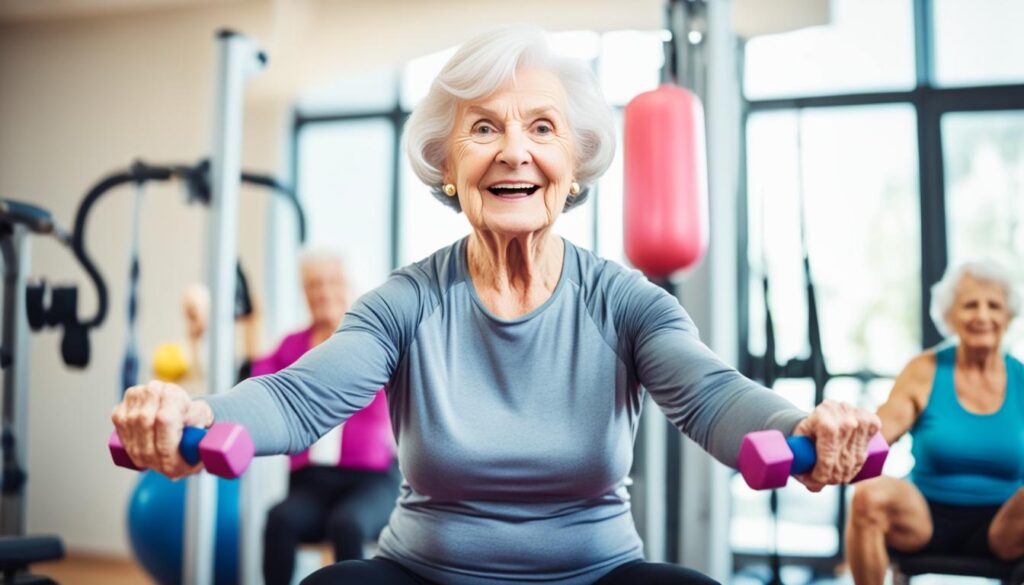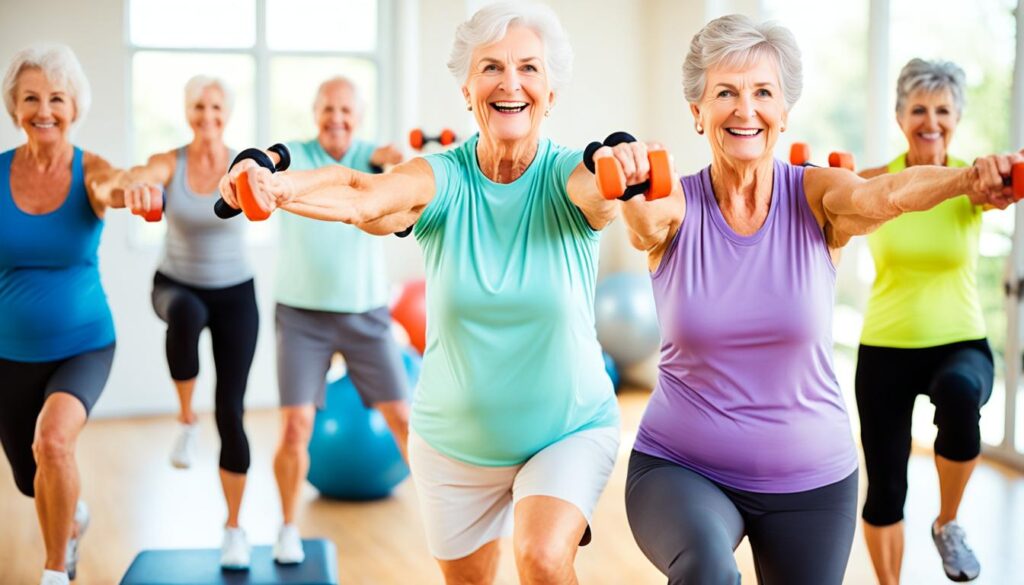Did you know that regular exercise can enhance the quality of life for seniors and reduce the risk of falls by 30%? Maintaining fitness routines for seniors is essential to promote independence and overall wellness. By focusing on a combination of strength, mobility, balance, and aerobic exercises, seniors can improve muscle strength, bone density, and heart health. Engaging in physical activities also makes it easier to perform daily tasks and boosts energy levels for a more active lifestyle.
Key Takeaways:
- Seniors should aim for at least 2.5 to 5 hours of moderate-intensity aerobic activity per week.
- Strength training exercises should focus on activities necessary for daily living.
- Balance exercises are crucial for seniors to maintain stability and reduce the risk of falls.
- Regular exercise offers numerous benefits, including increased energy levels and improved brain function.
- Consult with a healthcare professional to create a customized exercise plan that suits individual abilities and preferences.
Aerobic Exercises for Seniors
When it comes to senior fitness activities, aerobic exercises play a crucial role in maintaining cardiovascular health and overall wellness. Engaging in regular aerobic exercises can improve heart and lung function, boost energy levels, and enhance balance and coordination. Here are some recommended aerobic exercises for elderly adults:
1. Walking
Walking is one of the best aerobic exercises for seniors as it is low-impact and can be tailored to match individual pace and abilities. It can be done outdoors or indoors on a treadmill. Walking helps strengthen the muscles, improve joint flexibility, and increase endurance. Aim for at least 30 minutes of brisk walking most days of the week.
2. Cycling
Cycling is another effective cardio option for seniors. It is a low-impact exercise that increases heart and lung capacity while reducing stress on the joints. Cycling can be done outdoors on a bicycle or indoors on a stationary bike. It provides a great cardiovascular workout, strengthens the lower body muscles, and improves balance and coordination.
3. Dancing
Dancing is not only a fun and social activity but also a fantastic way to elevate the heart rate and improve strength and balance. Joining a dance class or participating in dance-based fitness programs can help seniors stay active and engaged. From ballroom dancing to Zumba, there are various dance styles suitable for different fitness levels.
4. Nature Walks
Nature walks are an excellent option for seniors who enjoy exploring the outdoors. Walking on uneven terrains challenges the body’s proprioception and improves overall strength, agility, and balance. Additionally, spending time in nature has been shown to have mental health benefits and reduce stress levels.
Remember to always start with a warm-up and finish with a cool-down to prevent injury and ease the body into and out of exercise. It is essential to listen to your body and adjust the exercises to your individual needs and abilities. Consulting with a fitness professional or healthcare provider can help create a personalized senior wellness routine.
| Aerobic Exercise | Benefits |
|---|---|
| Walking | Improves cardiovascular health, strengthens muscles, and enhances joint flexibility. |
| Cycling | Increases heart and lung capacity, strengthens lower body muscles, and improves balance. |
| Dancing | Elevates heart rate, improves strength and balance, and provides a fun and social activity. |
| Nature Walks | Challenges proprioception, enhances overall strength, agility, and balance, and reduces stress levels. |
Strength Training Exercises for Seniors
Strength training is essential for seniors to maintain muscle mass and bone density. As we age, our bodies naturally lose muscle mass and bone strength, making strength training exercises crucial for overall health and well-being. These exercises not only help seniors stay strong and independent but also improve flexibility and balance, reducing the risk of falls and injuries.
When developing senior citizen exercise plans, it’s important to focus on exercises that mimic daily activities. Movements like standing up from a chair without assistance or lifting groceries require strength in specific muscle groups, indicating overall health and functionality.
There are various options for strength training, including bodyweight exercises, free weights, and resistance bands. Bodyweight exercises, such as squats and lunges, help build strength in the lower body and improve balance. Free weights, like dumbbells or kettlebells, can be used to target specific muscle groups, such as the shoulders or arms. Resistance bands are another great option for seniors as they provide gentle resistance and are easily adjustable to individual fitness levels.
It’s important for seniors to incorporate exercises that target different muscle groups, including the shoulders, hips, and legs. Strengthening these areas not only improves flexibility and mobility but also enhances overall balance and stability.
Below are some examples of strength training exercises for seniors:
- Bodyweight Squats: Stand with feet shoulder-width apart, lower into a squat position by bending the knees, and then return to a standing position. Repeat for a set number of repetitions.
- Seated Leg Press: Sit on a chair with feet flat on the floor and push against the floor, extending the legs and activating the quadriceps muscles. Slowly return to the starting position. Repeat for a set number of repetitions.
- Bicep Curls: Hold a pair of dumbbells with arms extended and palms facing forward. Bend the elbows, bringing the dumbbells towards the shoulders, and then slowly lower them back down. Repeat for a set number of repetitions.
- Shoulder Press: Hold a pair of dumbbells at shoulder level with palms facing forward. Extend the arms upwards, bringing the dumbbells overhead, and then slowly lower them back down. Repeat for a set number of repetitions.
Remember to start with light weights and gradually increase the intensity as strength improves. It’s also important to maintain proper form and technique to reduce the risk of injury. Consulting with a fitness professional or physical therapist can help seniors develop a safe and effective strength training program tailored to their specific needs.

By incorporating strength training exercises into senior wellness routines and senior fitness programs, seniors can improve muscle mass, bone density, flexibility, and balance. These exercises contribute to a healthier and more independent lifestyle, reducing the risk of falls and enhancing overall quality of life.
Balance Exercises for Seniors
As we age, maintaining stability becomes increasingly important for seniors to reduce the risk of falls. Incorporating balance exercises into a senior’s fitness routine can significantly improve their equilibrium and proprioception. Here are a few effective balance exercises for seniors:
- Single Leg Stances: Standing on one leg with the support of a stool or kitchen counter can help seniors improve their balance and body awareness. This exercise challenges the core muscles and enhances stability.
- Tai Chi: This low-impact exercise combines flowing movements and deep breathing, promoting relaxation and mindfulness. Not only does Tai Chi improve balance, but it also enhances spatial awareness and reduces the risk of falls.
- Lower Body Strength Training: Exercises such as squats and heel raises can help strengthen the lower body, improving balance and stability. These exercises target the muscles necessary for maintaining upright posture and preventing falls.
It’s important for seniors to exercise caution while performing balance exercises, especially those who are at a higher risk of falling. Having a spotter or exercising in a safe environment is advised. By incorporating these balance exercises into their fitness routine, seniors can enhance their stability, reduce the risk of falls, and improve their overall quality of life.
The Importance of Balance Exercises for Seniors
“Balance exercises are crucial for seniors to maintain stability and reduce the risk of falls.”
Benefits of Exercise for Seniors
Regular exercise for seniors offers numerous benefits. It increases energy levels, strength, and overall fitness. Exercise can prevent or delay the onset of chronic conditions such as heart disease, diabetes, and certain cancers. It also helps manage symptoms of chronic conditions, improves mobility, flexibility, and balance, and supports independent living. Exercise has positive effects on brain function, mood, and sleep quality. Maintaining a healthy weight range is easier with regular exercise, and it contributes to an improved quality of life.
The Physical Benefits of Exercise
- Increased energy levels
- Improved strength and fitness
- Prevention or delay of chronic conditions
- Enhanced mobility, flexibility, and balance
- Support for independent living
- Improved weight management
The Mental and Emotional Benefits of Exercise
- Enhanced brain function
- Improved mood and well-being
- Better sleep quality
“Exercise is the key to a healthier, happier life. It’s never too late to start reaping the benefits.”
| Benefits | Description |
|---|---|
| Increased energy levels | Seniors who exercise regularly experience improved energy levels, making it easier to perform daily activities. |
| Improved strength and fitness | Exercise helps seniors build muscle strength and endurance, improving overall physical fitness. |
| Prevention or delay of chronic conditions | Regular exercise can reduce the risk of chronic conditions and delay their onset, promoting long-term health. |
| Enhanced mobility, flexibility, and balance | Seniors who exercise regularly enjoy improved mobility, flexibility, and balance, reducing the risk of falls and injuries. |
| Support for independent living | By improving strength, mobility, and balance, exercise helps seniors maintain their independence and perform daily activities without assistance. |
| Improved weight management | Regular exercise helps seniors maintain a healthy weight range, reducing the risk of obesity-related conditions. |
Tips for Exercising in Your 50s and Beyond
It’s never too late to prioritize your senior wellness routines and start reaping the benefits of regular exercise. As we age, consistency becomes even more crucial for maintaining optimal health. Aim to engage in 150 minutes of moderate aerobic activity or 75 minutes of vigorous aerobic activity per week. Combine this with strength training exercises and stretching routines to keep your elderly fitness regimens balanced and effective.
To make your senior fitness activities enjoyable and sustainable, vary your exercise routines to prevent boredom. You can incorporate activities like walking, swimming, yoga, or even dancing. Starting with small, achievable goals will help you build momentum and stay motivated. Gradually increase the intensity of your workouts over time as your body becomes more accustomed to the physical demands.
However, it’s important to be mindful of any existing health conditions or chronic pain. Consult with a healthcare professional before embarking on a new fitness program to ensure it aligns with your specific needs and limitations. They can provide guidance and tailor exercises to accommodate your unique situation. Additionally, tracking your heart rate during workouts and adjusting the intensity accordingly is essential for exercising safely and effectively.

